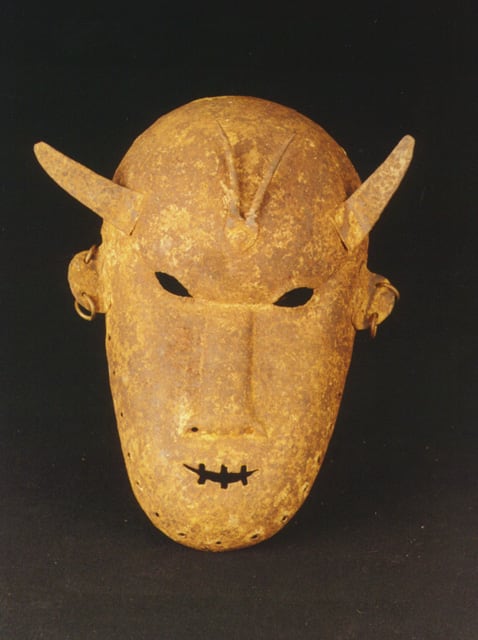Dogon Iron Face Mask with Horns, 19th Century CE - 20th Century CE
Iron
21 x 26.7 cm
8 1/4 x 10 1/2 in
8 1/4 x 10 1/2 in
PF.4402 (LSO)
This dynamic metal mask was made by the Dogon group of Mali. It is finely rendered, with a plain face shape perforated around the perimeter with small piercings, a pair...
This dynamic metal mask was made by the Dogon group of Mali. It is finely rendered, with a plain face shape perforated around the perimeter with small piercings, a pair of up-slanted almond-shaped eyes and a long, thick nose leading to a toothy smile. The sides of the head have pierced ears, while the apex of the face is adorned with a large pair of applied horns, and a smaller pair in the centre of the forehead. The metal is a pleasing shade due to the verdigris and patina that have formed since its manufacture.
The Dogon people of the Bandiagara escarpment, Mali, have been described as the most studied and least understood tribal group in Africa. Their culture is exceptionally complex, owing to their long history and internal variability. They moved to this area in the 15th century, escaping the Mande kingdom and slavery at the hands of Islamic groups, and displaced a number of tribes that were living on the escarpment at the time. They are excessively prolific in terms of artistic production; masks/figures in stone, iron, bronze/copper and of course wood are all known, in addition to cave/rock painting and adaptation of more modern materials. While Islam is prominent in and around the Dogon area, they have remained defiantly figurative in their artistic expression, a tradition which of course is technically banned under Islamic law.
There are 78 mask forms still in production (and numerous extinct variants), which have applications ranging from circumcision to initiation and funeral rites (damas), or commemorate twins, snakes, ancestors (nommo) and hogons (holy men). Secular items – such as headrests, granary doors/locks and troughs – are decorated with iconographic designs that bestow benedictions upon the user or owner. The Dogon took inspiration from the Tellem (lit. “we found them”) sculptures recovered from caves around the escarpment, notably human figures with upraised arms in what is believed to be a prayer for rainfall. Most figures were not made to be seen publicly, and are commonly kept by the spiritual leader (hogon) away from the public eye, in family houses or sanctuaries.
According to Dogon mythology, one of the original “nommo” ancestors became a blacksmith. To this day, metal – and particularly iron – is viewed as being a magical material, and the makers of it are both mysterious and revered. Being so hard to work, iron is also exceedingly expensive and prestigious, and we may make certain conclusions about this mask on the basis of this fact. This is an unusual and important piece of African art.
The Dogon people of the Bandiagara escarpment, Mali, have been described as the most studied and least understood tribal group in Africa. Their culture is exceptionally complex, owing to their long history and internal variability. They moved to this area in the 15th century, escaping the Mande kingdom and slavery at the hands of Islamic groups, and displaced a number of tribes that were living on the escarpment at the time. They are excessively prolific in terms of artistic production; masks/figures in stone, iron, bronze/copper and of course wood are all known, in addition to cave/rock painting and adaptation of more modern materials. While Islam is prominent in and around the Dogon area, they have remained defiantly figurative in their artistic expression, a tradition which of course is technically banned under Islamic law.
There are 78 mask forms still in production (and numerous extinct variants), which have applications ranging from circumcision to initiation and funeral rites (damas), or commemorate twins, snakes, ancestors (nommo) and hogons (holy men). Secular items – such as headrests, granary doors/locks and troughs – are decorated with iconographic designs that bestow benedictions upon the user or owner. The Dogon took inspiration from the Tellem (lit. “we found them”) sculptures recovered from caves around the escarpment, notably human figures with upraised arms in what is believed to be a prayer for rainfall. Most figures were not made to be seen publicly, and are commonly kept by the spiritual leader (hogon) away from the public eye, in family houses or sanctuaries.
According to Dogon mythology, one of the original “nommo” ancestors became a blacksmith. To this day, metal – and particularly iron – is viewed as being a magical material, and the makers of it are both mysterious and revered. Being so hard to work, iron is also exceedingly expensive and prestigious, and we may make certain conclusions about this mask on the basis of this fact. This is an unusual and important piece of African art.
